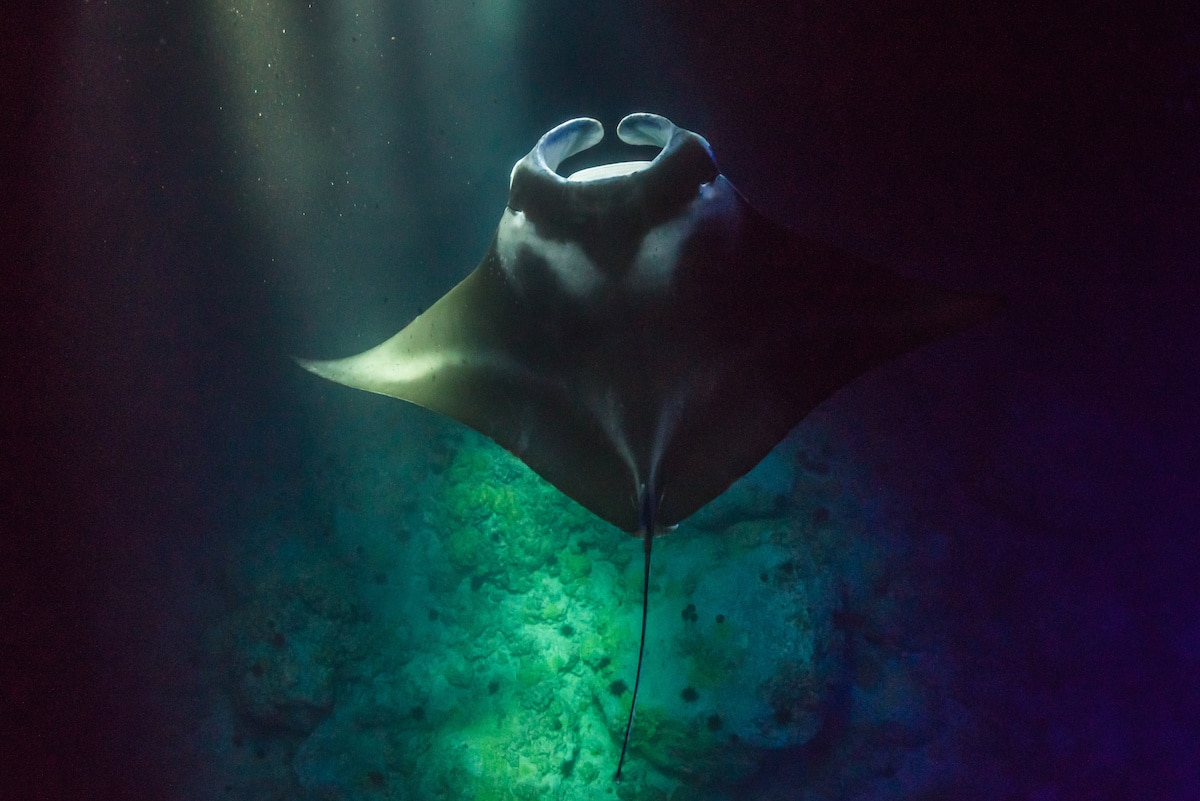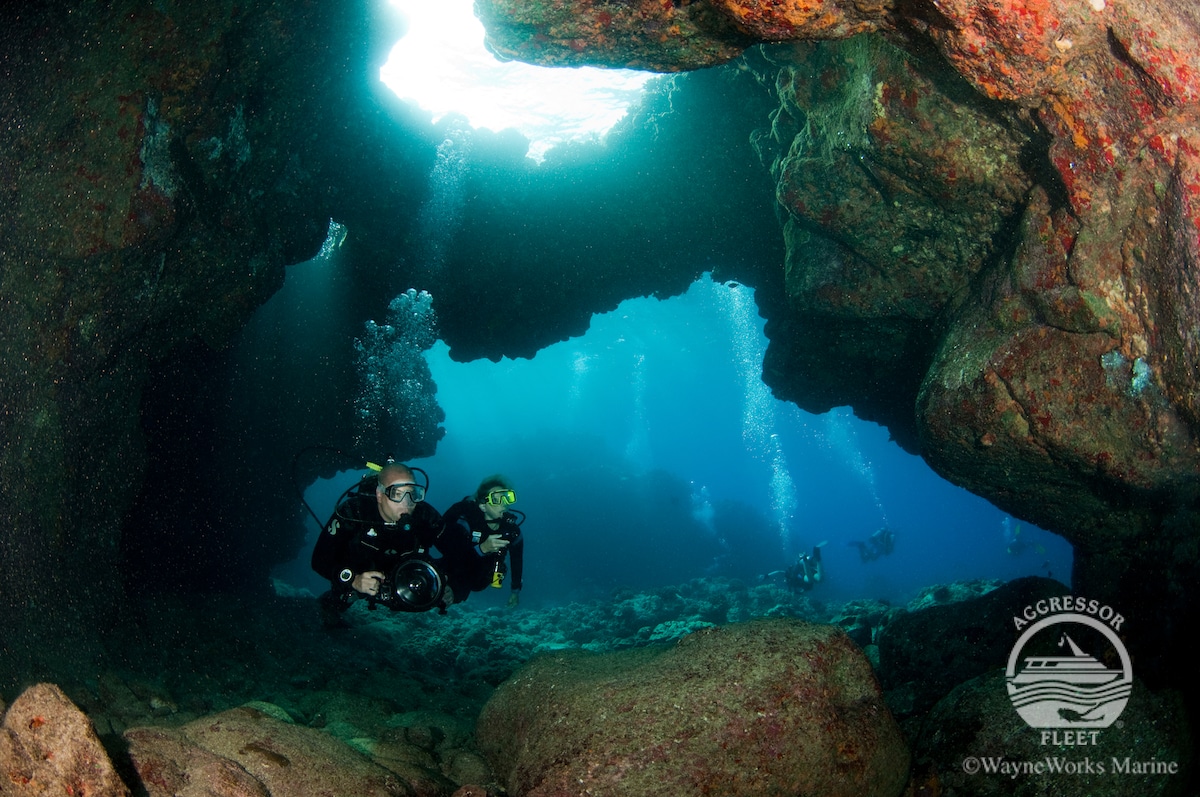This article was written by divers and writers at LiveAboard.com
 Discover liveaboard diving holiday solutions around the world at Liveaboard.com.
Discover liveaboard diving holiday solutions around the world at Liveaboard.com.


Hawaii is a lesser-known dive destination with a unique experience not to be missed: night diving with manta rays.
Manta ray encounters are high on divers’ wish lists and understandably so, putting on a show with their barrel rolls, feeding behaviour, and activities at manta cleaning stations. These rays are found around the world at top dive destinations such as the Maldives, but the best place to night dive with mantas is at Kona, a region of the Big Island of Hawaii.

Which Type Of Manta Rays Are Found At Hawaii?
There are two species of manta ray and reef manta rays are the ‘smaller’ of the two, growing to a huge 5.5 meters across. Reef manta rays are found in warm waters around the world, including Hawaii. This destination continues to be one of the best places in the world to spot reef mantas. The mantas are drawn to the area at night thanks to coastal resort lights attracting plankton, which the mantas feed on.
Which Are The Best Dive Sites Of Hawaii?
Hawaii scuba diving is diverse and isn’t just about the manta rays. The Hawaiian island chain is made up of 132 islands with plentiful dive sites and constantly changing underwater scenery, thanks to the active volcanoes found there. There is a broad range of dives to suit all abilities and interests.

Big Island
Big Island has more than 50 dive sites, with lava tubes, coral gardens and numerous types of fish found only at Hawaii. The dive sites are peaceful and it is a prime destination for liveaboards. Highlights include a tall pinnacle rising from the ocean floor at Paradise Pinnacle, the Tubastrea Tunnel swim-through and turtles found at Turtle Pinnacle.
Kona is rugged and dramatic, with volcanic basalt and hard coral formations. The mountains drop steeply into the depths and these deep waters attract large pelagics to the area. Whilst Kona is famous for its night dives with manta rays, you can also see sharks, whales and dolphins.
O’Ahu
This island is home to countless eagle rays, frog fish, turtles and the YO-257 and San Pedro wrecks. Diving from O’Ahu in the summer allows accessibility to the famous Hawaiian North Shore dive sites such as Shark’s Cove and Three Tables.
Maui
Black Rock is a popular site at Maui but there are plenty of others with pristine coral reefs. The Molokini Crater of Maui is a dive highlight, with mantas, sharks and whales, whilst the St. Anthony and Carthaginian artificial reefs teem with biodiversity.

Moloka’i
Molokai has 40 dive sites and a 30-mile-long segment of pristine reef with outstanding diving. There are shallow and deep dives with plenty of marine life, including hammerhead sharks and rare Hawaiian monk seals – found at Fish Bowl, Fish Rain and Deep Corner.
Lana’i
The caverns of Lana’i are a dive highlight with fantastic water visibility, and Cathedrals I and II are popular for finding new fish species and rare invertebrates. Divers visiting in winter may also see humpback whales.
Kaua’i
Kaua’i is the place to visit for encounters with numerous green sea turtles and also whitetip reef sharks. Turtles Bluff has sand caves, sharks and turtle cleaning stations.

What Kind of Diver Is Hawaii Diving Suitable For?
Hawaii diving is suitable for all experience levels, and night diving with mantas is available for both divers and snorkelers. Exploring Hawaii by liveaboard allows divers to explore the best of each island more easily and to reach the remote islands all during one safari. The Kona Aggressor II offers night diving with mantas as part of their safaris.
When Is The Best Time To Dive Hawaii?
Diving is possible all year but the best time to visit is during winter, when divers may hear humpback whales as they migrate through the area. The water temperature varies from 24°C (75.2°F) to 26°C (78.8°F).
This article was written by divers and writers at LiveAboard.com
 Discover liveaboard diving holiday solutions around the world at Liveaboard.com.
Discover liveaboard diving holiday solutions around the world at Liveaboard.com.

Whether you are a beginner or a professional diver – with the three new main regulators from DYNAMICNORD, everyone will find their favourite regulator. They all look super stylish.
Quality and performance are the be-all and end-all for regulators. It is not for nothing that the TR stands for Tec Reg. The innovative design of the TR-80 guarantees absolute reliability – even in ice-cold waters.

Perfect breathing effort at 0.8 J/l / certified for diving in waters below 10 degrees / structural design made of solid brass for best cold protection / membrane-compensated design with dry seal of the first stage / reduced exhalation effort thanks to optimized exhalation membrane and bubble deflector / adjustable Venturi (dive/predive) and adjustment knob for individual inhalation comfort / innovative design of the front cover prevents free-flow in strong currents or when diving with scooters / design made of sandblasted brass, matt chrome finish / 2 HP and 4 LP outlets / mouthpiece made of high-quality, anti-allergic silicone for maximum comfort.


The IR-50 is the top regulator for advanced and experienced divers. Natural breathing is the essence of this regulator.

Ideal breathing effort at 0.8 J/l /certified for diving in waters below 10 degrees / compensated membrane / adjustable venturi (dive/predive) and adjustment knob for individual inhalation comfort/ outlet valve and deflector for minimum exhalation effort and reduction of bubbles on the face / design made of sandblasted brass, matt chrome finish / 2 HP and 4 NP outlets / mouthpiece made of high-quality, anti-allergic silicone for maximum comfort.


For diving centres and diving beginners – the workhorse stands for strong construction, reliability and robustness. Perfect for your training.

Optimal breathing effort at 0.8 J/l /recommended for diving in waters above 10 degrees / non-compensated piston / adjustable venturi (dive/predive) / outlet valve and deflector for minimum exhalation effort and reduction of bubbles on the face / design made of sandblasted brass, matt chrome finish / 1 HP and 3 NP outlets / mouthpiece made of high-quality, anti-allergic silicone for maximum comfort.


The OP-30 is the ideal addition to all DYNAMICNORD regulators. It is identical in construction to the CS-30.

The TR-80, IR-50, CS-30 (DIN & INT) regulators and the Octopus OP-30 are available from DYNAMICNORD dealers and in the online store.
DYNAMICNORD – Your Outdoor Companion.

Renowned anti-whaling activist Paul Watson has been released from custody in Greenland after spending five months in detention. Denmark’s Justice Ministry rejected Japan’s request for his extradition, citing insufficient guarantees that his time already served in custody would be credited against any potential sentence.
The 74-year-old Canadian-American was arrested on July 21 in Nuuk, Greenland’s capital, when his ship docked to refuel. His arrest was based on a 2012 Japanese warrant related to a 2010 encounter in Antarctic waters. Japan alleged Watson obstructed operations and caused damage to a whaling research ship during efforts to disrupt illegal whaling. Watson has consistently denied these claims, maintaining his commitment to marine conservation.
Denmark, which oversees extradition matters for Greenland, concluded that while the legal conditions for extradition were met, the lack of assurances from Japan regarding time-served credit made extradition untenable.
In a video shared by his foundation, Watson expressed gratitude and relief, saying, “After five months, it’s good to be out… and good to know they’re not sending me to Japan.” He added that the most difficult part of his time in custody was being separated from his two young sons.
Watson is a pioneering figure in marine conservation, known for founding the Captain Paul Watson Foundation in 2022 after decades of activism with the Sea Shepherd Conservation Society. His bold efforts to defend marine life have earned him widespread support, including from celebrities and conservationists. His work has also been featured in the acclaimed reality TV series Whale Wars.
Watson’s lawyer, Jonas Christoffersen, praised the decision, stating, “We are happy and relieved that Paul Watson is now free.” He added that Watson is eager to reunite with his family and continue his vital work.
The arrest occurred while Watson’s vessel, the M/Y John Paul DeJoria, was en route to the North Pacific with a team of 26 volunteers to intercept a Japanese whaling ship. His foundation described the arrest as politically motivated and emphasized that Watson’s actions were focused on ending illegal whaling practices.
Japan resumed commercial whaling in 2019 after leaving the International Whaling Commission, asserting that whale meat is a cultural tradition. Conservationists, however, continue to challenge these practices, highlighting their impact on marine ecosystems.
Despite the challenges, Watson remains steadfast in his mission to protect marine life and bring attention to whaling practices. His dedication to ocean conservation has made him a globally respected advocate for the environment.


Iconic SS United States to become the World’s Largest Artificial Reef


Book Review – 52 Assignments: Underwater Photography


DYNAMICNORD – New German diving brand enters the British market


Exploring Cenote El Pit: A Diver’s Dream


Try BARE drysuits (and maybe even win one!) this Friday with Sea & Sea at North West Dive Fest


Book Review: Coral Triangle Cameos


Dive the Egyptian Red Sea this Autumn with Regaldive


2024 Ocean Art Underwater Photo Competition Announced